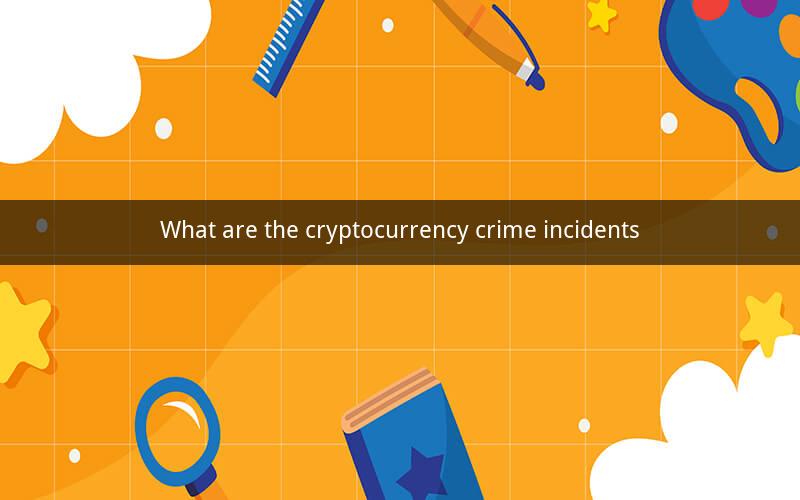
Cryptocurrency Crime Incidents: An Overview
Table of Contents
1. Introduction to Cryptocurrency Crime
2. Types of Cryptocurrency Crime
- Hacking and Phishing
- Fraudulent ICOs and Ponzi Schemes
- Money Laundering
- Thefts and Burglaries
- Market Manipulation
3. Impact of Cryptocurrency Crime
4. Prevention and Detection Measures
- Security Best Practices
- Legal Frameworks
- International Collaboration
5. Case Studies
- The Mt. Gox Collapse
- The DAO Hack
- The Bitconnect Scandal
6. Conclusion
1. Introduction to Cryptocurrency Crime
Cryptocurrency crime incidents have become increasingly prevalent as the digital currency market has grown. These crimes often involve the unauthorized use, theft, or manipulation of digital assets. Understanding the nature and scope of these incidents is crucial for both individuals and organizations involved in the cryptocurrency ecosystem.
2. Types of Cryptocurrency Crime
2.1 Hacking and Phishing
Hacking and phishing are among the most common forms of cryptocurrency crime. Hackers exploit vulnerabilities in software or trick individuals into revealing their private keys or other sensitive information. This can lead to the theft of substantial amounts of cryptocurrency.
2.2 Fraudulent ICOs and Ponzi Schemes
Initial Coin Offerings (ICOs) have been a popular method for raising funds in the cryptocurrency space. However, many fraudulent ICOs have emerged, promising high returns with little to no real value behind the projects. Ponzi schemes, which rely on new investors' money to pay off earlier investors, are also a significant concern.
2.3 Money Laundering
Cryptocurrency's pseudo-anonymous nature makes it an attractive tool for money laundering. Illicit funds can be mixed with legitimate transactions, making it difficult to trace the original source of the money.
2.4 Thefts and Burglaries
Physical theft of cryptocurrency can occur when devices containing private keys or digital assets are stolen. This includes thefts from exchanges, wallets, and individuals' homes.
2.5 Market Manipulation
Market manipulation involves attempts to control or distort the price of a cryptocurrency. This can be done through false news, coordinated trading, or spreading misinformation.
3. Impact of Cryptocurrency Crime
The impact of cryptocurrency crime can be severe. It can lead to financial loss for individuals and organizations, undermine trust in the cryptocurrency ecosystem, and deter potential investors. Additionally, it can have broader implications for financial stability and security.
4. Prevention and Detection Measures
4.1 Security Best Practices
Security measures are essential for preventing cryptocurrency crime. This includes using strong passwords, enabling two-factor authentication, and regularly updating software.
4.2 Legal Frameworks
Establishing clear legal frameworks is crucial for addressing cryptocurrency crime. This involves defining what constitutes a crime, setting penalties, and creating mechanisms for reporting and investigating incidents.
4.3 International Collaboration
Cryptocurrency crime often transcends national borders, making international collaboration essential. This includes sharing information, coordinating investigations, and harmonizing legal approaches.
5. Case Studies
5.1 The Mt. Gox Collapse
The collapse of the Mt. Gox exchange in 2014 was one of the most significant cryptocurrency crime incidents. The exchange lost approximately 850,000 bitcoins, valued at over $400 million at the time.
5.2 The DAO Hack
In 2016, the DAO, a decentralized autonomous organization, was hacked, resulting in the theft of about 3.6 million ETH. This incident highlighted vulnerabilities in smart contracts and the need for improved security measures.
5.3 The Bitconnect Scandal
Bitconnect, a cryptocurrency lending platform, collapsed in 2018 after allegations of fraud and manipulation. The company's collapse resulted in significant financial losses for investors.
6. Conclusion
Cryptocurrency crime incidents are a significant challenge for the digital currency ecosystem. Understanding the types of crimes, their impact, and the measures to prevent and detect them is essential for maintaining trust and security in the cryptocurrency market.
---
Questions and Answers
1. What is the primary difference between hacking and phishing in the context of cryptocurrency crime?
- Hacking involves exploiting software vulnerabilities, while phishing tricks individuals into revealing sensitive information.
2. How can individuals protect themselves from fraudulent ICOs?
- Conduct thorough research on the project, its team, and its whitepaper. Be wary of promises of high returns with little risk.
3. What is the role of international collaboration in addressing cryptocurrency crime?
- It facilitates the sharing of information, coordination of investigations, and harmonization of legal approaches across borders.
4. How did the Mt. Gox collapse affect the cryptocurrency market?
- It led to a significant loss of trust in the cryptocurrency market and prompted a reevaluation of security measures.
5. What are some common security best practices for cryptocurrency users?
- Use strong, unique passwords, enable two-factor authentication, and keep private keys secure.
6. How does money laundering occur in the cryptocurrency space?
- Illicit funds are mixed with legitimate transactions, making it difficult to trace the original source.
7. What are smart contracts, and how did the DAO hack occur?
- Smart contracts are self-executing contracts with the terms directly written into code. The DAO hack exploited vulnerabilities in the smart contract code.
8. What measures can be taken to prevent market manipulation in cryptocurrencies?
- Implementing strict regulations, increasing transparency, and monitoring trading patterns for suspicious activity.
9. How did the Bitconnect scandal unfold, and what were the consequences?
- Bitconnect promised high returns on cryptocurrency lending, but it collapsed after allegations of fraud, leading to significant financial losses for investors.
10. What is the importance of legal frameworks in addressing cryptocurrency crime?
- They define what constitutes a crime, set penalties, and provide mechanisms for reporting and investigating incidents.